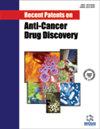真核启动因子 3C 可通过调控 p53 信号通路影响卵巢癌的增殖和侵袭
IF 4.1
4区 医学
Q3 ONCOLOGY
Recent patents on anti-cancer drug discovery
Pub Date : 2024-04-17
DOI:10.2174/0115748928292248240401051408
引用次数: 0
摘要
背景:真核生物起始因子 3C(EIF3C)是真核生物中一个关键的转译起始因子,已被证明可促进各种肿瘤的进展。然而,它在卵巢癌中的机理作用仍不明确。研究方法本研究采用免疫组化法检测了 EIF3C 在卵巢癌组织中的表达。此外,通过降低卵巢癌细胞中 EIF3C 的表达,评估了细胞增殖、侵袭和凋亡能力的变化。通过微阵列分析,对下调 EIF3C 组和对照组卵巢癌细胞进行了比较,发现了表达不同的基因。此外,还验证了与细胞增殖相关的信号通路。利用异种移植肿瘤模型研究了 EIF3C 在体内的功能作用。结果显示免疫组化分析表明,EIF3C水平升高与卵巢癌患者的不良预后有关。抑制 EIF3C 会大大阻碍 SK-OV-3 和 HO-8910 细胞的生长和扩散,同时增强细胞的程序性死亡。通过对差异表达基因进行KEGG和GSEA富集分析,发现p53信号通路与EIF3C相关。抑制 EIF3C 会导致 p53 信号通路上调,从而抑制细胞增殖和侵袭,促进细胞凋亡。体内实验表明,EIF3C 基因敲除抑制了裸鼠皮下肿瘤的生长。结论卵巢癌患者肿瘤组织中 EIF3C 的过度表达与预后较差有关。通过影响 p53 信号通路,EIF3C 促进了卵巢癌细胞的生长和浸润。本文章由计算机程序翻译,如有差异,请以英文原文为准。
Eukaryotic Initiation Factor 3C Can Affect the Proliferation and Invasion of Ovarian Cancer by Regulating the p53 Signalling Pathway
Background: Eukaryotic Initiation Factor 3C (EIF3C) represents a pivotal translational initiation factor in eukaryotes and has been shown to facilitate the progression of various neoplasms. However, its mechanistic role in ovarian cancer remains elusive. Methods: In this research, the expression of EIF3C in ovarian cancer tissues was investigated using immunohistochemistry. In addition, the assessments were made on changes in cellular proliferation, invasion, and apoptotic abilities by reducing the expression of EIF3C in ovarian cancer cells. By utilizing microarray analysis, a comparison was performed between the downregulated EIF3C group and the control group of ovarian cancer cells, revealing the genes that were expressed differently. Furthermore, the signalling pathways associated with cellular proliferation were validated. The functional role of EIF3C in vivo was investigated using a xenograft tumour model. Results: The immunohistochemical analysis showed that elevated levels of EIF3C are linked to a negative prognosis in patients with ovarian cancer. Suppression of EIF3C greatly hindered the growth and spread of SK-OV-3 and HO-8910 cells while enhancing cellular programmed cell death. Following KEGG and GSEA enrichment analyses of differentially expressed genes, the p53 signalling pathway was found to be associated with EIF3C. Suppression of EIF3C resulted in the upregulation of the p53 signalling pathway, leading to the inhibition of cell proliferation and invasion and the promotion of apoptosis. In vivo experiments demonstrated that EIF3C knockdown suppressed the growth of subcutaneous tumours in nude mice. Conclusion: There is a correlation between overexpression of EIF3C in tumour tissues of ovarian cancer patients and this is associated with a poorer prognosis. By influencing the p53 signaling pathway, EIF3C facilitates the growth and infiltration of cells in ovarian cancer.
求助全文
通过发布文献求助,成功后即可免费获取论文全文。
去求助
来源期刊
CiteScore
4.50
自引率
7.10%
发文量
55
审稿时长
3 months
期刊介绍:
Aims & Scope
Recent Patents on Anti-Cancer Drug Discovery publishes review and research articles that reflect or deal with studies in relation to a patent, application of reported patents in a study, discussion of comparison of results regarding application of a given patent, etc., and also guest edited thematic issues on recent patents in the field of anti-cancer drug discovery e.g. on novel bioactive compounds, analogs, targets & predictive biomarkers & drug efficacy biomarkers. The journal also publishes book reviews of eBooks and books on anti-cancer drug discovery. A selection of important and recent patents on anti-cancer drug discovery is also included in the journal. The journal is essential reading for all researchers involved in anti-cancer drug design and discovery. The journal also covers recent research (where patents have been registered) in fast emerging therapeutic areas/targets & therapeutic agents related to anti-cancer drug discovery.

 求助内容:
求助内容: 应助结果提醒方式:
应助结果提醒方式:


